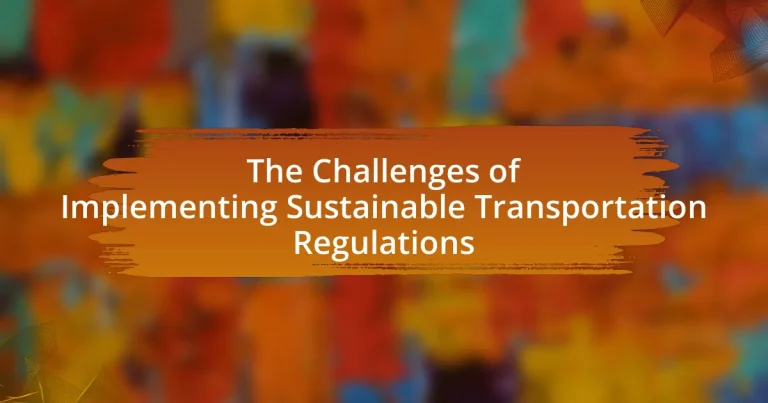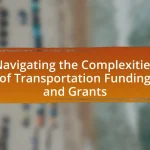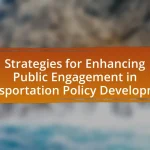The article examines the challenges associated with implementing sustainable transportation regulations, focusing on political resistance, funding limitations, and public acceptance. It highlights the difficulty of achieving consensus among diverse stakeholders, including government, industry, and the public, due to differing priorities and values. Financial barriers, such as high initial costs and ongoing operational expenses, further complicate the adoption of sustainable solutions. The article also discusses the role of technology in facilitating compliance and the environmental and social implications of inadequate regulations, emphasizing the need for effective strategies to overcome these challenges.
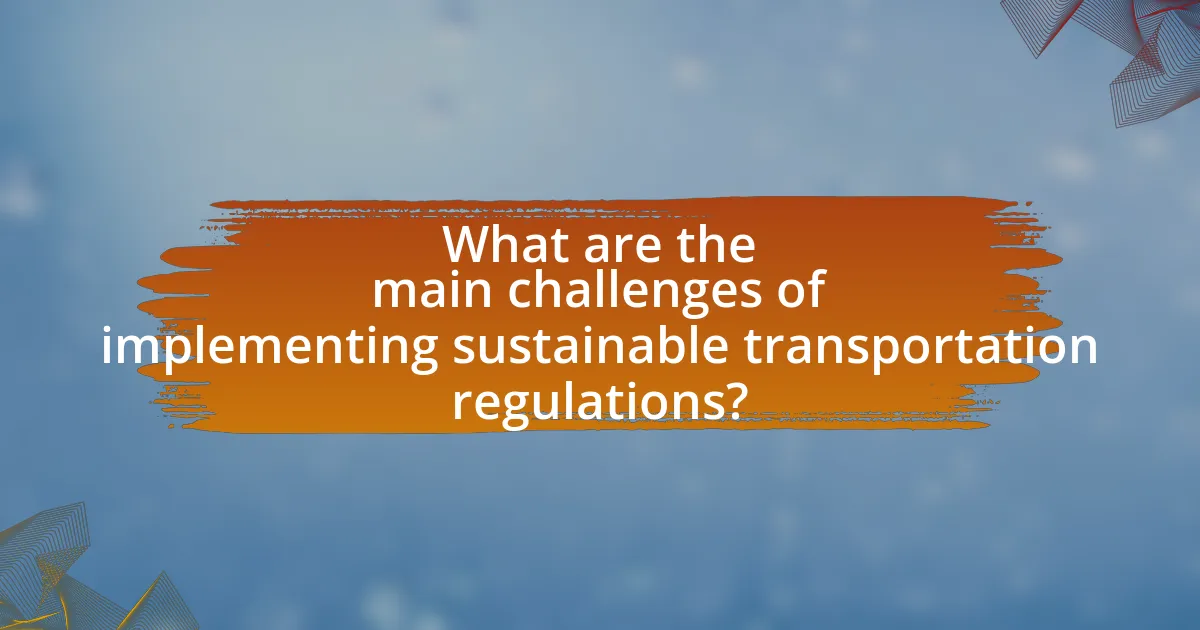
What are the main challenges of implementing sustainable transportation regulations?
The main challenges of implementing sustainable transportation regulations include political resistance, funding limitations, and public acceptance. Political resistance often arises from stakeholders who prioritize short-term economic gains over long-term environmental benefits, making it difficult to pass necessary legislation. Funding limitations hinder the development and maintenance of sustainable infrastructure, as governments may lack the financial resources to invest in new technologies or public transit systems. Public acceptance is crucial, as communities may resist changes to their transportation habits or infrastructure, fearing inconvenience or increased costs. These challenges are supported by studies indicating that successful implementation requires overcoming these barriers through comprehensive planning and stakeholder engagement.
Why is it difficult to achieve consensus among stakeholders?
Achieving consensus among stakeholders is difficult due to differing priorities, interests, and values. Stakeholders often represent various sectors, such as government, industry, and community groups, each with unique objectives and concerns regarding sustainable transportation regulations. For instance, while environmental advocates may prioritize ecological impacts, industry representatives might focus on economic viability and job preservation. This divergence in goals creates challenges in finding common ground. Additionally, the complexity of transportation systems and the long-term implications of regulations further complicate discussions, as stakeholders may have varying levels of understanding and commitment to sustainability.
What roles do government, industry, and the public play in this consensus?
Government, industry, and the public each play crucial roles in achieving consensus on sustainable transportation regulations. The government establishes policies and regulations that set the framework for sustainable practices, such as emissions standards and funding for public transportation initiatives. Industry stakeholders, including manufacturers and service providers, are responsible for innovating and implementing technologies that comply with these regulations, often collaborating with government to ensure feasibility and effectiveness. The public influences this consensus through advocacy, feedback, and participation in public consultations, which can shape policy decisions and drive demand for sustainable options. For instance, public support for electric vehicles has prompted both government incentives and industry investments in charging infrastructure, demonstrating the interconnected roles of these entities in promoting sustainable transportation.
How do differing priorities among stakeholders complicate regulation efforts?
Differing priorities among stakeholders complicate regulation efforts by creating conflicts that hinder consensus and collaboration. For instance, government agencies may prioritize environmental sustainability, while businesses often focus on cost-effectiveness and profit margins. This divergence can lead to resistance against regulations perceived as burdensome, as seen in the automotive industry where manufacturers lobby against stringent emissions standards to protect their economic interests. Additionally, community groups may advocate for public health and safety, further complicating the regulatory landscape as their needs may clash with those of industry stakeholders. Such competing interests can delay the implementation of necessary regulations, as seen in various transportation initiatives where negotiations stall due to these conflicting priorities.
What are the financial barriers to implementing these regulations?
The financial barriers to implementing sustainable transportation regulations include high initial investment costs, ongoing operational expenses, and potential economic impacts on businesses. High initial investment costs arise from the need for infrastructure upgrades, such as electric vehicle charging stations and public transit enhancements, which can require millions of dollars in funding. Ongoing operational expenses, including maintenance and staffing for new systems, can strain budgets, particularly for municipalities with limited financial resources. Additionally, businesses may face economic impacts due to increased compliance costs, which can lead to resistance against adopting these regulations. For instance, a study by the International Council on Clean Transportation found that cities implementing electric vehicle infrastructure faced upfront costs averaging $1 million per charging station, highlighting the significant financial burden associated with these regulations.
How do initial costs impact the adoption of sustainable transportation solutions?
Initial costs significantly hinder the adoption of sustainable transportation solutions by creating a financial barrier for individuals and organizations. High upfront investments in technologies such as electric vehicles, charging infrastructure, and renewable energy sources often deter potential adopters, as they may perceive these costs as prohibitive compared to traditional transportation options. For instance, a study by the International Council on Clean Transportation found that the higher purchase price of electric vehicles compared to gasoline vehicles can lead to a slower adoption rate, despite lower operating costs over time. This financial hesitation is compounded by the lack of immediate economic incentives or subsidies, which can further delay the transition to sustainable alternatives.
What funding sources are available to support sustainable transportation initiatives?
Funding sources available to support sustainable transportation initiatives include federal grants, state and local government funding, private investments, and nonprofit organization contributions. Federal grants such as those from the Congestion Mitigation and Air Quality Improvement Program provide significant financial resources for projects aimed at reducing transportation-related emissions. Additionally, state and local governments often allocate budgetary funds for sustainable transportation projects, while private investments from companies focused on sustainability can also play a crucial role. Nonprofit organizations frequently offer grants and funding opportunities specifically aimed at promoting sustainable transportation solutions.
How does technology influence the implementation of sustainable transportation regulations?
Technology significantly influences the implementation of sustainable transportation regulations by enabling data-driven decision-making and enhancing compliance monitoring. Advanced technologies such as Geographic Information Systems (GIS) and real-time data analytics allow policymakers to assess transportation patterns, identify areas for improvement, and optimize resource allocation. For instance, cities utilizing smart traffic management systems have reported reductions in congestion and emissions, demonstrating the effectiveness of technology in achieving regulatory goals. Furthermore, the integration of electric vehicle infrastructure and smart charging solutions supports the transition to cleaner transportation options, aligning with sustainability objectives. These technological advancements provide concrete evidence that they facilitate the enforcement and effectiveness of sustainable transportation regulations.
What technological advancements are necessary for effective regulation?
Technological advancements necessary for effective regulation include real-time data analytics, blockchain technology, and artificial intelligence. Real-time data analytics enables regulators to monitor transportation systems continuously, ensuring compliance with sustainability standards. Blockchain technology enhances transparency and traceability in supply chains, allowing for better enforcement of regulations. Artificial intelligence can analyze vast amounts of data to identify patterns and predict compliance issues, facilitating proactive regulatory measures. These advancements collectively improve the efficiency and effectiveness of regulatory frameworks in sustainable transportation.
How do existing technologies pose challenges to new regulations?
Existing technologies challenge new regulations by creating complexities in compliance and enforcement. For instance, the rapid advancement of electric vehicles and autonomous driving technologies often outpaces regulatory frameworks, leading to gaps in safety standards and operational guidelines. A study by the International Transport Forum highlights that the integration of these technologies requires adaptive regulatory approaches that can accommodate innovation while ensuring public safety. Additionally, existing technologies may not align with new sustainability goals, as seen in the case of legacy transportation systems that are resistant to change, complicating the transition to greener alternatives.
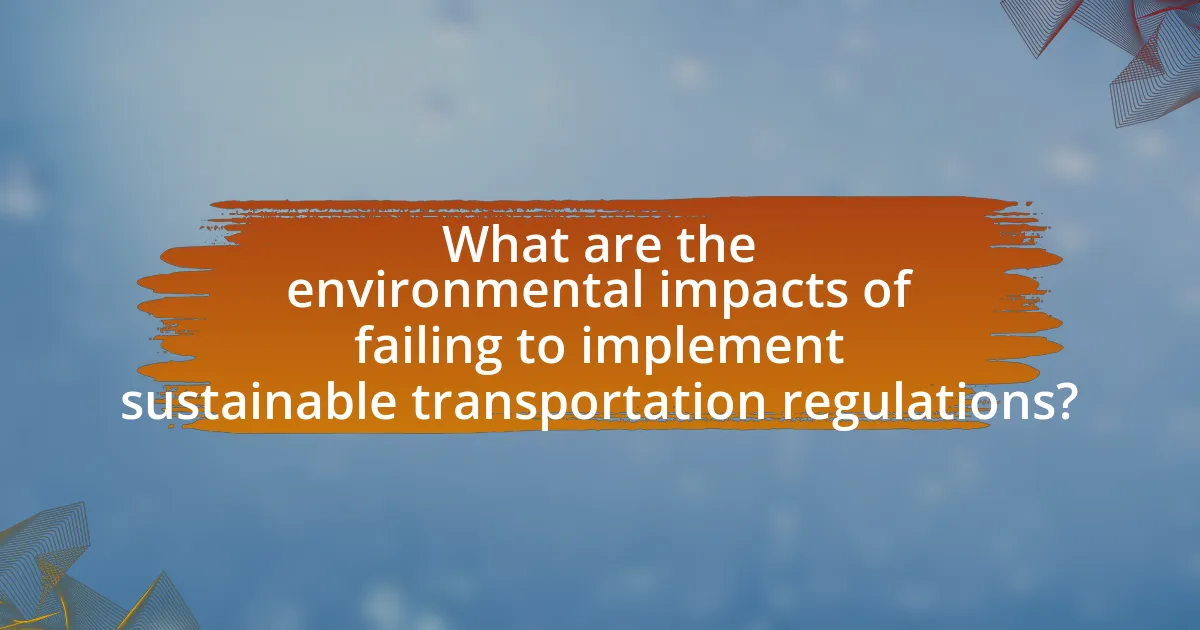
What are the environmental impacts of failing to implement sustainable transportation regulations?
Failing to implement sustainable transportation regulations leads to increased greenhouse gas emissions, air pollution, and habitat destruction. Transportation is a significant contributor to global carbon dioxide emissions, accounting for approximately 24% of total emissions in 2019, according to the International Energy Agency. Without regulations promoting cleaner technologies and practices, reliance on fossil fuels continues, exacerbating climate change and public health issues. Additionally, the lack of sustainable practices can result in urban sprawl, which further encroaches on natural habitats, leading to biodiversity loss and ecosystem degradation.
How does transportation contribute to climate change?
Transportation significantly contributes to climate change primarily through greenhouse gas emissions, particularly carbon dioxide, produced by vehicles that burn fossil fuels. In 2019, the transportation sector accounted for approximately 29% of total greenhouse gas emissions in the United States, making it a major source of pollution. The reliance on gasoline and diesel fuels in cars, trucks, and airplanes leads to the release of these gases, which trap heat in the atmosphere and contribute to global warming. Additionally, the construction and maintenance of transportation infrastructure, such as roads and airports, also generate emissions through the use of heavy machinery and materials.
What specific emissions are associated with traditional transportation methods?
Traditional transportation methods, such as gasoline and diesel vehicles, are primarily associated with emissions of carbon dioxide (CO2), nitrogen oxides (NOx), particulate matter (PM), and volatile organic compounds (VOCs). These emissions contribute significantly to air pollution and climate change. For instance, the U.S. Environmental Protection Agency (EPA) reported that transportation accounted for 29% of total greenhouse gas emissions in 2019, with light-duty vehicles being a major contributor. Additionally, NOx emissions from vehicles can lead to the formation of ground-level ozone, which poses health risks and environmental damage.
How can sustainable transportation mitigate these emissions?
Sustainable transportation can mitigate emissions by promoting the use of low-emission vehicles, enhancing public transit systems, and encouraging active transportation modes like walking and cycling. These strategies reduce reliance on fossil fuels, which are a primary source of greenhouse gas emissions. For instance, electric vehicles produce zero tailpipe emissions, and cities that invest in efficient public transit can significantly lower per capita emissions; studies show that public transit can reduce individual carbon footprints by up to 45%. Additionally, increasing infrastructure for cycling and walking can lead to a decrease in short car trips, which are often less efficient and more polluting.
What are the social implications of inadequate transportation regulations?
Inadequate transportation regulations lead to significant social implications, including increased traffic accidents, environmental degradation, and social inequities. For instance, a lack of stringent safety regulations can result in higher rates of vehicle collisions, which, according to the National Highway Traffic Safety Administration, accounted for over 38,000 fatalities in the United States in 2020. Furthermore, insufficient environmental regulations contribute to air pollution, disproportionately affecting low-income communities that are often located near major transportation corridors. Studies show that these communities experience higher rates of respiratory diseases, highlighting the health disparities caused by inadequate regulations. Additionally, poor transportation policies can limit access to essential services and employment opportunities, exacerbating social inequities and hindering economic mobility.
How does transportation inequity affect marginalized communities?
Transportation inequity significantly impacts marginalized communities by limiting their access to essential services, employment opportunities, and social interactions. This inequity often results from inadequate public transit options, higher transportation costs, and geographic isolation, which disproportionately affect low-income and minority populations. For instance, a study by the Transportation Research Board found that individuals in low-income neighborhoods spend a higher percentage of their income on transportation compared to those in affluent areas, exacerbating economic disparities. Additionally, marginalized communities frequently face longer travel times and reduced mobility, which can hinder their ability to participate fully in the economy and society.
What role does public health play in the discussion of sustainable transportation?
Public health plays a critical role in the discussion of sustainable transportation by highlighting the health benefits of reducing vehicle emissions and promoting active transportation modes such as walking and cycling. Research indicates that sustainable transportation can lead to lower rates of respiratory diseases, cardiovascular issues, and obesity, as active commuting encourages physical activity and reduces air pollution. For instance, a study published in the journal “Environmental Health Perspectives” found that increased cycling and walking can significantly decrease the incidence of chronic diseases, thereby improving overall public health outcomes. Thus, integrating public health considerations into sustainable transportation policies is essential for fostering healthier communities and mitigating health-related costs associated with pollution and sedentary lifestyles.
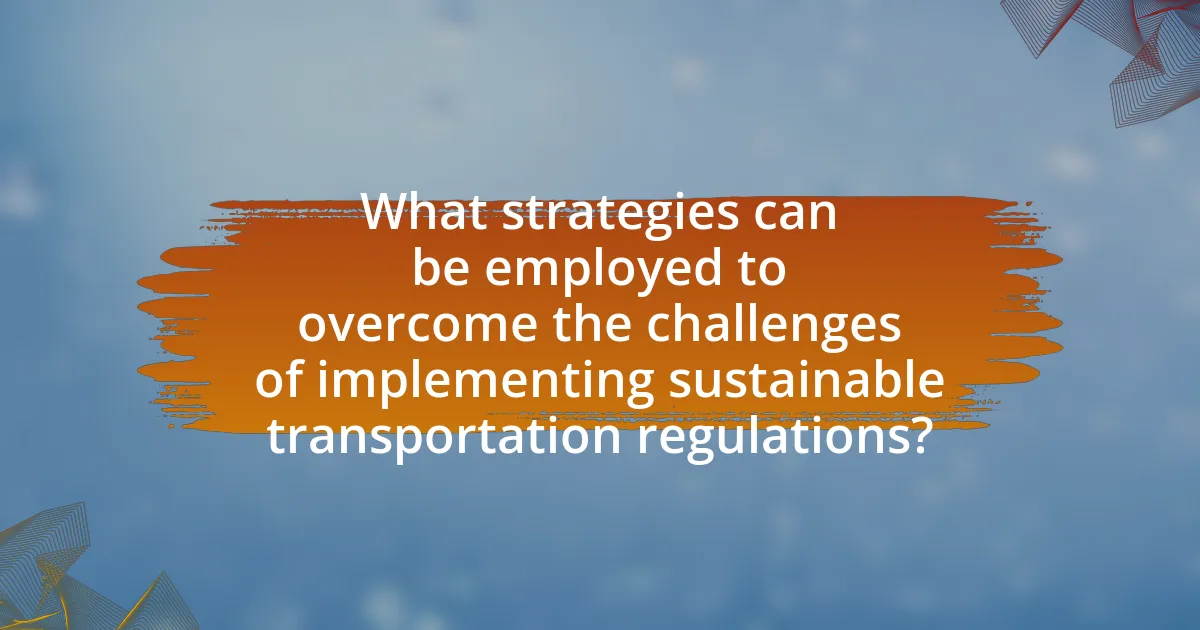
What strategies can be employed to overcome the challenges of implementing sustainable transportation regulations?
To overcome the challenges of implementing sustainable transportation regulations, governments can adopt a multi-faceted approach that includes stakeholder engagement, financial incentives, and robust data collection. Engaging stakeholders, such as local communities, businesses, and transportation agencies, fosters collaboration and ensures that regulations meet diverse needs. Financial incentives, such as subsidies for electric vehicles or grants for public transit improvements, encourage adoption and compliance. Additionally, robust data collection and analysis enable policymakers to assess the effectiveness of regulations and make informed adjustments. For instance, cities that have implemented congestion pricing, like London, have seen reduced traffic and increased public transport use, demonstrating the effectiveness of strategic regulation.
How can stakeholder engagement be improved?
Stakeholder engagement can be improved by implementing structured communication strategies that facilitate transparency and collaboration. Effective methods include regular stakeholder meetings, surveys to gather feedback, and the use of digital platforms for ongoing dialogue. Research indicates that organizations that actively involve stakeholders in decision-making processes see a 30% increase in project success rates, as highlighted in the study “Stakeholder Engagement: A Roadmap to Meaningful Involvement” by the International Association for Public Participation. This approach not only fosters trust but also ensures that diverse perspectives are considered, leading to more sustainable transportation regulations.
What methods can be used to facilitate dialogue among stakeholders?
Methods to facilitate dialogue among stakeholders include structured workshops, facilitated discussions, and collaborative platforms. Structured workshops allow stakeholders to engage in focused conversations, ensuring that all voices are heard and that specific issues are addressed systematically. Facilitated discussions, often led by neutral third parties, help to mediate differing viewpoints and foster understanding among diverse groups. Collaborative platforms, such as online forums or shared digital workspaces, enable continuous communication and information sharing, allowing stakeholders to contribute asynchronously and maintain engagement over time. These methods are effective in creating a conducive environment for dialogue, as evidenced by successful stakeholder engagement initiatives in various sectors, including urban planning and environmental policy.
How can public awareness campaigns influence stakeholder involvement?
Public awareness campaigns can significantly enhance stakeholder involvement by educating the public about sustainable transportation issues and mobilizing community support. These campaigns raise awareness of the environmental, social, and economic benefits of sustainable practices, which can lead to increased public demand for stakeholder engagement in policy-making. For instance, a study by the American Public Transportation Association found that communities with active public awareness campaigns saw a 30% increase in local stakeholder participation in transportation planning meetings. This demonstrates that informed citizens are more likely to advocate for sustainable transportation initiatives, thereby influencing stakeholders to prioritize these issues in their agendas.
What funding strategies can support sustainable transportation initiatives?
Funding strategies that can support sustainable transportation initiatives include public-private partnerships, government grants, and dedicated taxes or fees. Public-private partnerships leverage private investment to fund infrastructure projects, reducing the financial burden on public entities while promoting innovation. Government grants, such as those from the Federal Transit Administration, provide essential funding for projects that enhance public transit and reduce emissions. Additionally, dedicated taxes or fees, like vehicle registration fees or carbon taxes, can generate revenue specifically earmarked for sustainable transportation projects, ensuring a consistent funding stream. These strategies have been successfully implemented in various regions, demonstrating their effectiveness in advancing sustainable transportation goals.
How can public-private partnerships enhance funding opportunities?
Public-private partnerships (PPPs) can enhance funding opportunities by leveraging the financial resources and expertise of both sectors to address infrastructure needs. These collaborations allow public entities to access private capital, reducing the burden on government budgets while accelerating project delivery. For instance, according to a report by the World Bank, PPPs can mobilize significant private investment, with over $1 trillion committed globally to infrastructure projects since 1985. This influx of funding enables the development of sustainable transportation systems, which often require substantial upfront investment. By sharing risks and responsibilities, PPPs create a more attractive investment environment, encouraging private sector participation in projects that align with public goals.
What innovative financing models are being explored in sustainable transportation?
Innovative financing models being explored in sustainable transportation include public-private partnerships (PPPs), green bonds, and mobility-as-a-service (MaaS) funding mechanisms. Public-private partnerships leverage both government and private sector resources to fund infrastructure projects, allowing for shared risk and investment. Green bonds are specifically designed to raise funds for projects with environmental benefits, such as electric vehicle infrastructure, and have seen significant growth, with the global green bond market reaching over $1 trillion in issuance by 2021. Mobility-as-a-service funding models integrate various transportation services into a single accessible platform, often supported by subscription fees or usage-based payments, promoting sustainable options like shared mobility and public transit. These models are gaining traction as they align financial incentives with sustainability goals, addressing the funding gap in sustainable transportation initiatives.
What best practices can be adopted for successful implementation?
Successful implementation of sustainable transportation regulations can be achieved by adopting stakeholder engagement, clear communication, and data-driven decision-making. Engaging stakeholders, including government agencies, community members, and industry representatives, fosters collaboration and ensures diverse perspectives are considered, which is crucial for addressing the complexities of transportation systems. Clear communication of goals, benefits, and expectations helps to align all parties involved, reducing resistance and enhancing cooperation. Data-driven decision-making, supported by empirical evidence and analysis, allows for informed choices that can adapt to changing circumstances and improve outcomes. For instance, cities that have successfully implemented sustainable transportation policies, such as Copenhagen, have demonstrated that involving citizens in the planning process and utilizing real-time data can lead to more effective and accepted regulations.
How can pilot programs inform larger-scale sustainable transportation initiatives?
Pilot programs can inform larger-scale sustainable transportation initiatives by providing empirical data and insights into the effectiveness of specific strategies. These programs allow for the testing of new technologies, policies, and practices in a controlled environment, enabling stakeholders to assess their feasibility and impact before broader implementation. For instance, a pilot program that tests electric buses in a city can reveal operational challenges, user acceptance, and cost implications, which can then be addressed in a larger rollout. Research indicates that cities that have implemented pilot programs, such as Los Angeles with its Mobility on Demand initiative, have successfully identified best practices and potential pitfalls, leading to more informed decision-making in subsequent large-scale projects.
What lessons can be learned from successful case studies in sustainable transportation?
Successful case studies in sustainable transportation reveal that collaboration among stakeholders is essential for effective implementation. For instance, the integration of public transit systems with cycling infrastructure in cities like Copenhagen has led to a significant increase in bike usage, demonstrating that coordinated planning can enhance accessibility and reduce reliance on cars. Additionally, financial incentives for electric vehicle adoption in California have shown that economic measures can accelerate the transition to sustainable options, as evidenced by a 2019 report indicating a 50% increase in electric vehicle sales due to such incentives. These examples underscore the importance of stakeholder engagement and economic strategies in overcoming challenges associated with sustainable transportation regulations.
